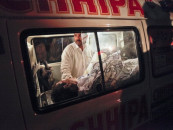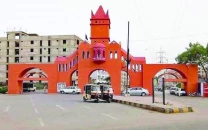One bite to end it all: Treading carefully in Thar
Most of the people are attacked usually after sunset when it is generally very dark.

This picture shows a snake charmer performing with a Pakistan Black Cobra, one of the deadly snakes found in Pakistan. PHOTO: FILE
Dozen of species of snakes can be found in Thar, out of which cobras, Sindhi Krait (Bungarus sindanus), Russel’s viper, saw-scaled viper, Dhaaman Rattlesnake and sand boa, are the most common and largest in number.
According to assistant district health officer, Dr Prabhu Lal, most of the patients are bitten by vipers known as Lundi bala in local slang. “It is not always possible to identify the species of snake because they are not trapped and killed and at times, not even seen by the victim. Most of the people are attacked usually after sunset when it is generally very dark.”
In the absence of reliable snake identification, the doctors administer a polyvalent antivenom vaccine in which patients are given the vaccination depending on the amount of venom and type of snake - a practice avoided in the developed countries. According to Dr Ghulam Shah Nizamani, a haematologist teaching at Isra University Hyderabad, the common symptoms include fright, fang marks, swelling, bleeding, drooling and breathing problems. The poison of some dangerous snakes can kill a victim in a few hours. The delayed treatment usually results in respiratory or cardiac failure, paralysis, hemorrhaging, degeneration of organs and tissues.
Published in The Express Tribune, July 20th, 2013.



















COMMENTS
Comments are moderated and generally will be posted if they are on-topic and not abusive.
For more information, please see our Comments FAQ